|
EDWARD,
ARTHUR AND PETER
Part
II
A
trip to
Liu
Kung Island
by
Peter
Hunt
Liu
Kung
Island
Today
|
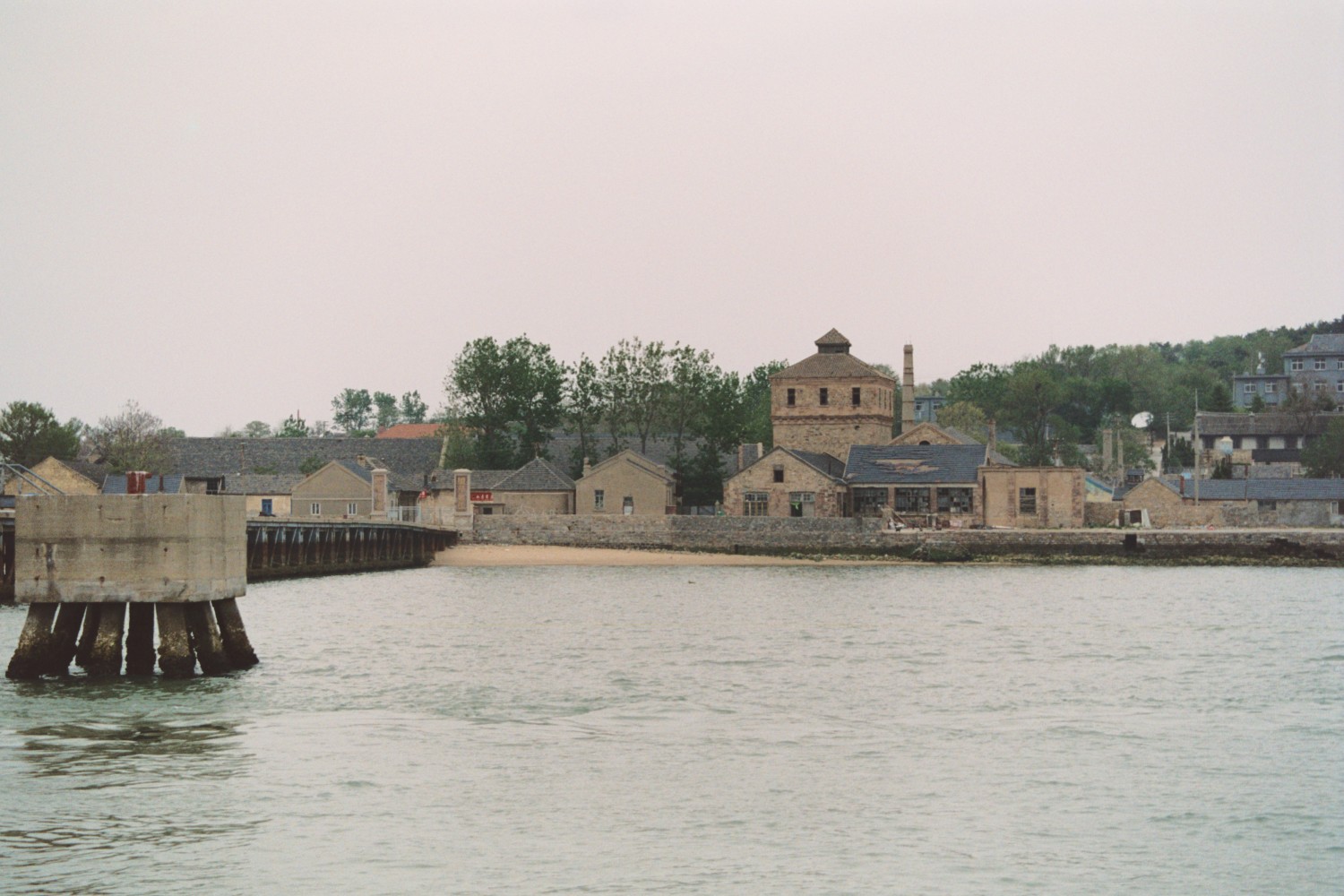
|
|
The Liu Kung Dao
waterfront - the coaling pier on the left was used by the real Ting
Yuen |
Practically
nothing of the pre-dreadnought era or the colonial days remains in Wei Hai
today. However, for the price of
a 40 RMB return ferry trip to Liu Kung you will find the opposite to be
true. There are a lot of modern
structures on the island but the past still predominates.
Admiral Ting lived here and would still be at home in most of it
today. The original coaling
jetty and the old buildings on the waterfront date from his day.
Further uphill you’ll find bourgeois villas and detached houses
from the 1920s that are laid out in lanes and parks like an ideal well-to-do
English seaside town. It’s all
a bit odd as the colonialists created a replica of English towns as they
should be, not as they really were. The
best analogy that I could think of was imagining how a real American from
turn of the Century Middle-America would feel if he was plopped down into
Disneyland
’s “Main Street USA”. But
the island is no museum or theme park. The
lower town buildings still house a naval academy and the upper class villas
are now schools, kindergarten, officers quarters and guesthouses.
Whilst
the island isn’t a museum it does have two museums on it, and good ones
they are too. A lot of Mainland
museums can be a frustrating, even traumatic, experience for lovers of
history as they are often poorly cared for, superficial and seemingly only
kept open to eke out a tacky souvenir trade.
Liu Kung’s museums, however are not only good by Chinese standards,
they are world class.
The
Museum of the Sino-Japanese War is the star.
There is nothing “high tech” about this place but for me it
scored big on several points. For
a start it is located in the original buildings of the Beiyang Fleet’s
Headquarters Yaman. Here Admiral
Ting received his ridiculous orders from the Empress Dowager and was torn
between obedience and common sense as he fought the Japanese.
 |
| The museum
entrance |
The
conference rooms and some of Ting’s offices have been left as they were.
Being adorned with well-executed wax works dummies they tell a story
in time in a very effective way. If
you have been to the “Battle Box” in
Singapore
you will know the feeling. The
main point that they made to me was one of incongruity ~ although Ting was
fighting a modern war, commanding steam powered leviathans he still lived in
the environment of a Ching dynasty mandarin.
The
exhibition galleries are well laid out and, again unlike many Mainland
museums, the captions were clearly written by people who knew what they were
taking about. So, for instance,
the captions on the photos of the various forts give details of the
armament. Not all of this is in English but if you know the historical
background of what you are looking at, with a bit of Chinese and a bit of
common sense you can make things out. The
Museum is obviously very proud of its academic efforts and has its own
journal. The Museum’s CD ROM
and publications are also well worth getting.
The only thing that detracts from this is that the room attendants
are typical of their ilk, i.e. disinterested to the point of
unconsciousness, who resentfully eye the visitors depriving them of their
afternoon nap. However I got the
distinct impression that if you contacted the museum in advance and
explained your interest I’m sure that they could find someone who actually
gives a damn to discuss the exhibits with you.
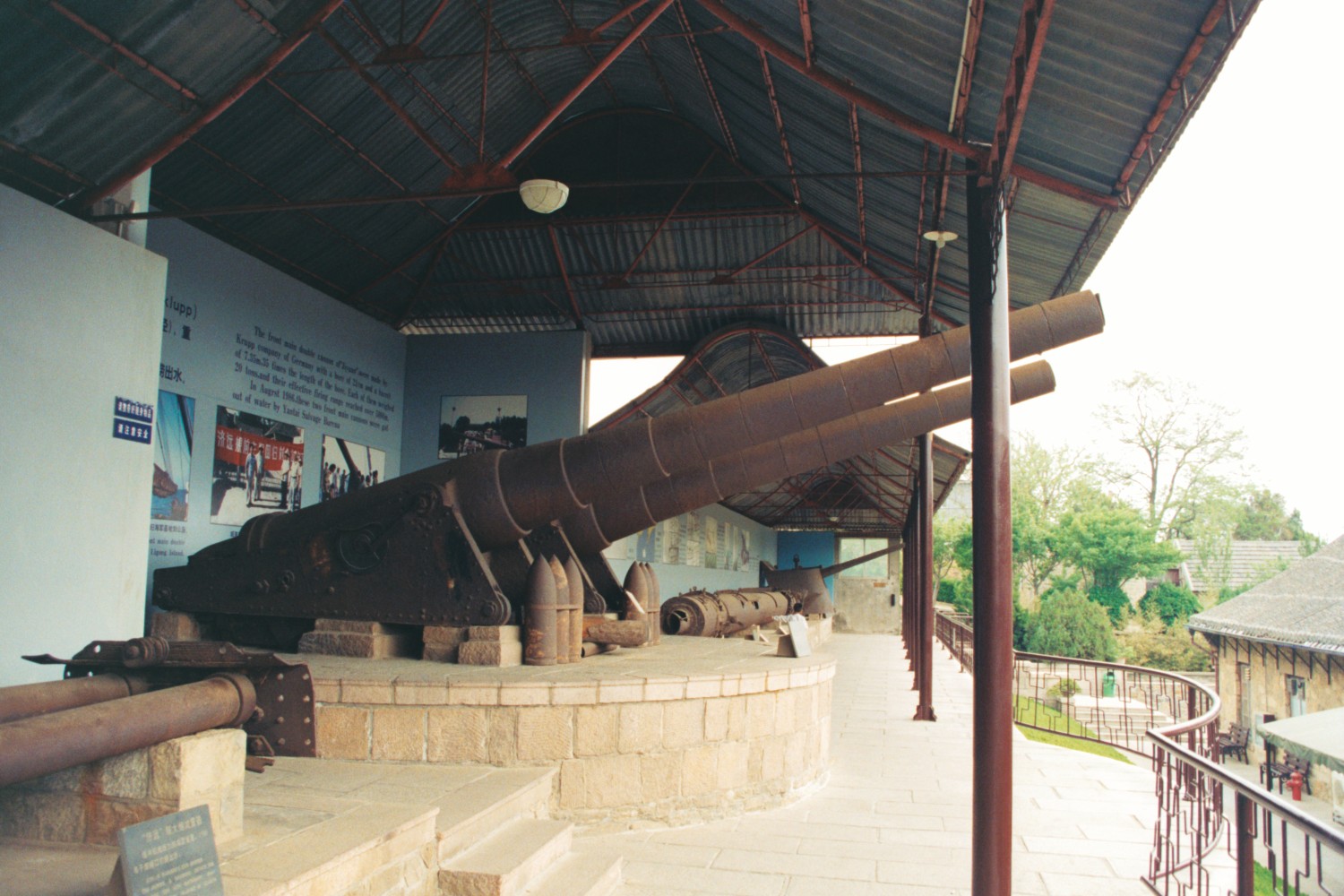 |
| Tsi Yuen's
21cm Krupp main guns |
At
the back of the Museum is some hardware that requires little explanation ~
the main guns of the protected cruiser Tsi Yuen.
She was built in
Stettin
as part of the same contract as the Ting Yuens and had an interesting
history. It was the Tsi Yuen
that Captain Togo attacked before the declaration of war on 25July 1894.
Although outnumbered the Tsi Yuen managed to escape, but with her
superstructure wrecked and her guns disabled.
Repaired, she fought at the Yalu, and survived only to eventually
surrender with the rest of the fleet at Wei Hai.
She was taken into Japanese service as the Sai Yen.
She went to war against the Russians but was sunk by a mine off
Port Arthur
in 1904. In 1986 the wreck was
located and the guns and many artifacts recovered, which were shared between
the Liu Kung and Lushan museums.
As
you leave the Museum there is yet more firepower on your right.
For 20 RMB you can climb all over a 280 mm Krupp gun which has been
moved here from its original site. Although
there are other guns on the island “in their natural habitat”, as it
were, you can get right up close to this beast, so it is well worth the
price of admission.
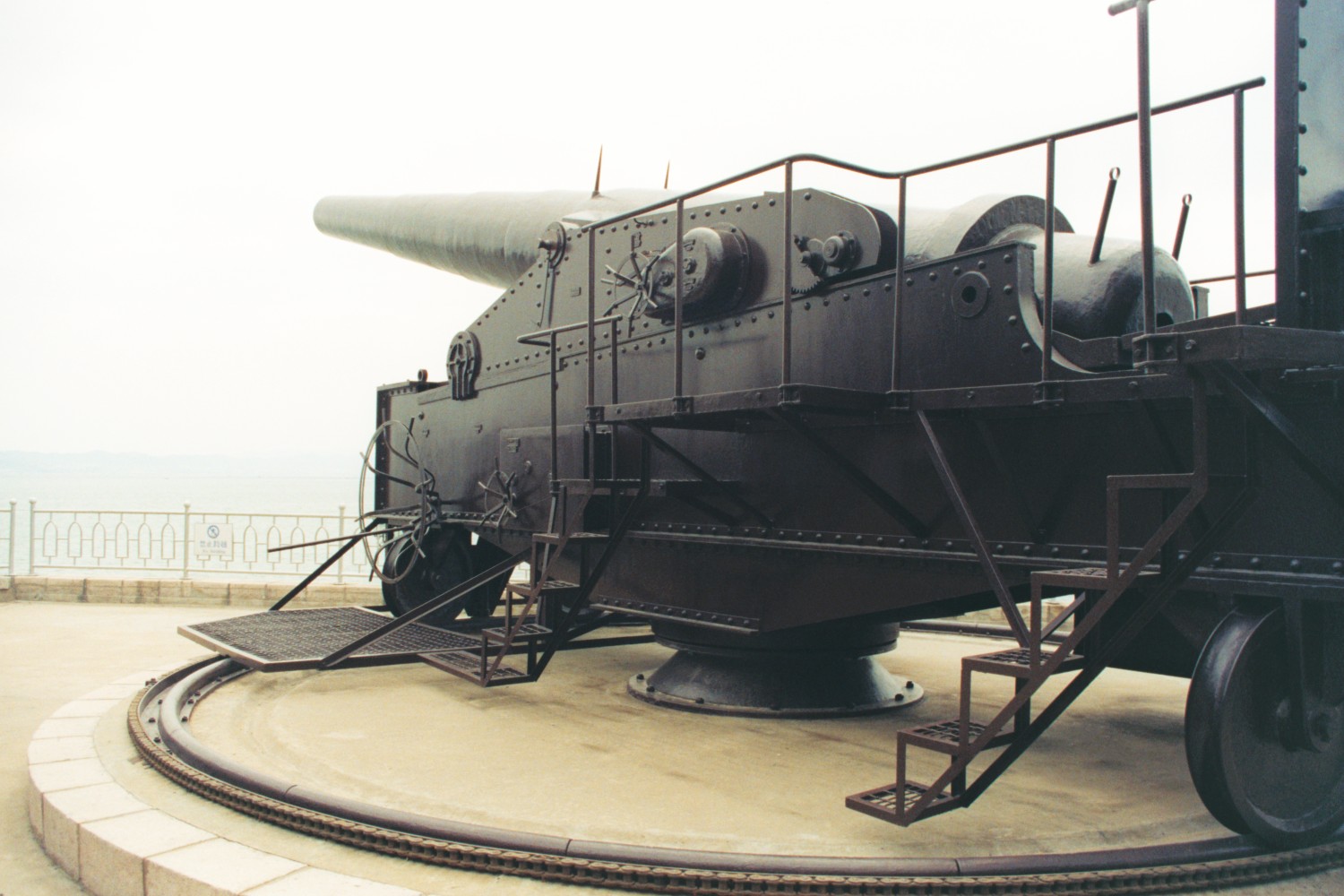 |
| The 28cm
Krupp outside the museum |
To
the west of the Museum are located most of the original buildings on the
island. They are still in use so
you cannot enter many of them but the area still makes for an evocative
stroll. East of the museum are
the modern buildings. You see a shopping centre, mercifully located mostly
underground; a monstrous new ferry pier; and then a remarkable and massive
bust of Admiral Ting gazing out to sea that marks the entrance to “The
Exhibition Hall of the Sino-Japanese War in 1894”.
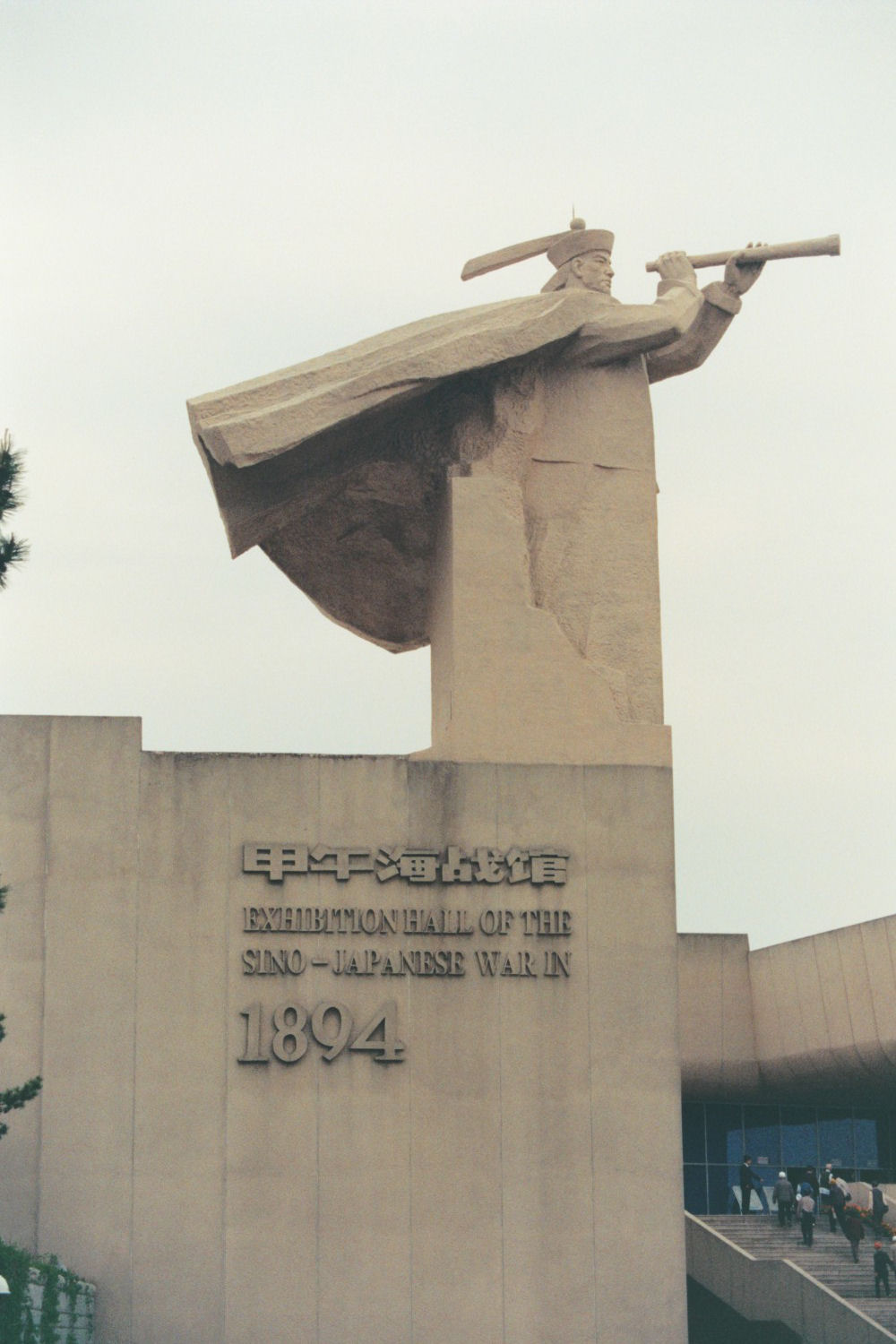 |
| Admiral Ting
looks out over the entrance to the exhibition hall |
The
Exhibition Hall tells the story of the war in a series of displays and
vignettes using wax works, photographs, multi-media and narration.
The narration is all in Putongwha but again, if you know a bit about
the history you will be able to follow what is going on.
Perhaps it is not very high brow but I found the Exhibition Hall to
be both educational and entertaining. I
particularly enjoyed a CGI movie showing the 25July battle between the Tsi
Yuen and the Japanese cruisers and the Japanese sinking of the British
merchantman Kowshing which was transporting Chinese troops to
Korea
. Between them the Museum and
the Exhibition Centre cover the entire educational spectrum from popular to
academic so there is something to offer everyone.
The two facilities compliment each other well and I recommend both to
you.
Liu
Kung is about three km long , two km wide and 150 meters high at its highest
point. A walking tour is
possible in a day, although I’m not sure how much remains of many of the
batteries so, other than for fitness freaks, I don’t know how worthwhile
this would be. Although, even
without any history, the views of the rugged north shore would repay a
little effort in getting there. Less
strenuous ways of getting about exist. There
is a cable-car to the monument perched nearly on the centre of the island,
and the southern shore is serviced by 10-seater electric buggies that run a
circular sightseeing service for 10 RMB.
These buggies only stop for a few moments at each site to take photos
but for 100 RMB you can hire a whole buggy.
The driver can’t leave the prescribed route but he can stop for
longer and give you time to explore. If
you want to spend a lot of time though you will have to “compensate” him
some more for his lost time. On
my trip this wasn’t really a problem since the most westerly positions on
the small
Hwang
Island
were inaccessible because the causeway was closed.
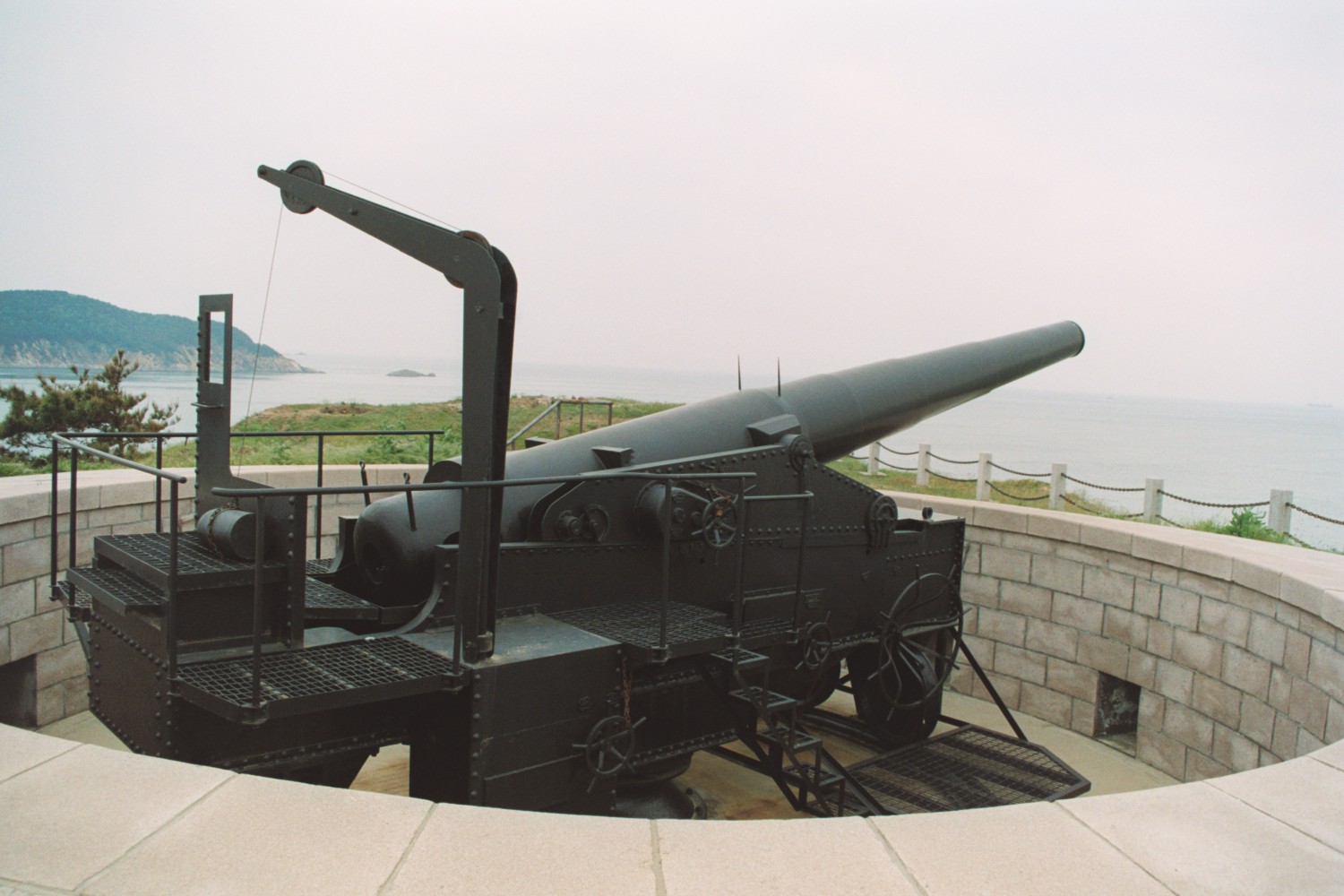 |
| One of the
24cm Krupps at Donghoing Fort |
Any
disappointments that I had in the west were more than compensated for by a
visit to the most easterly battery on the island at Donghoing Fort.
This position originally mounted two 240 mm Krupp guns and two 120
mm. One of the latter has been
moved down to the fort’s courtyard. For
the price of admission you get to wander at will through empty but well
preserved barracks, magazines and shell rooms dug into the hill.
Then, following a long gallery upwards you emerge at the watershed on
the eastern point of the island. Here
there is the other 120 mm. Looking
back towards Wei Hai you get good views of the little
Jih
Island
whose fortifications covered the eastern approaches to the bay.
Turning out to sea and following the path around you get good views
of Liu Kung’s northern cliffs which are still guarded by the two 240 mm
guns in their concrete pits. There
is also a command bunker but, since
Tyler
relates that there were no range finders on the island in his day, it is
probably a later addition. This is a bit odd because the works were
installed under the direction of the German advisor Von Hanneken, and, when
built, they were 'state of the art’. They should have included the
best 1890s fire control systems such as depression rangefinders. The
fact that they didn’t is perhaps another example of a weak power arming
quickly and spending the money on impressive hardware, without investing in
the software to make it really effective. In any event Von Hanneken
built well and the fort was kept in use until the 1980s.
Overall
we spent about five hours on Liu Kung including the ferry trips.
This was a comfortable amount of time.
You can whistle-stop the place, but for the pre-dreadnought buff it
is such a treasure trove that this would not be satisfying.
To walk all of the battery positions as well would take the best part
of a day. Whatever you do I
think that time spent on Liu Kung Dao is well spent.
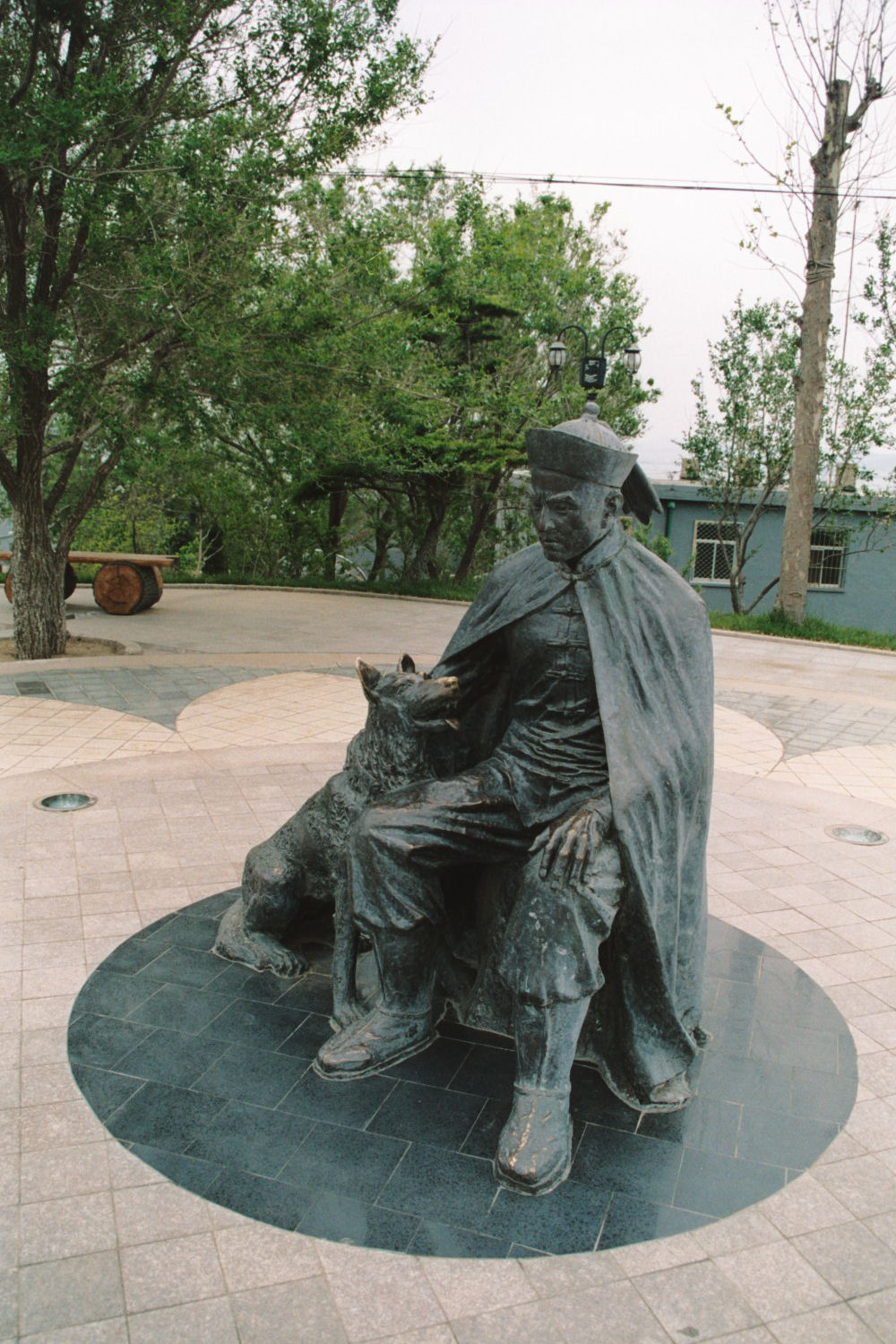 |
| Admiral Ting
with best friend |
On
to Lushan
There
is a lot of history in Lushan, but, unfortunately, a lot of paranoia too.
All but three of the sites are off limits to 'foreigners', by which
they mean white folks since they don’t check anyone else.
Still the place is very well worth a visit and is easy to get to from
Dalien. You can hire a taxi for
the afternoon for 200 RMB.
On
the drive down you get good views of the rugged terrain on the peninsular
where the Russians fought their delaying actions in 1904.
There is still a lot of Russian architecture in the town which is
much more spread out than I had assumed from my readings.
I was expecting the hills to give a “punch bowl” effect but the
basin is a lot wider and the hills less dominant than I had thought.
Indeed from the centre of town the only dominant hills are those by
the shore, all of which were securely held by the Russians in 1904.
Thus the fleet could continue to operate even though
Port Arthur
was besieged.
|
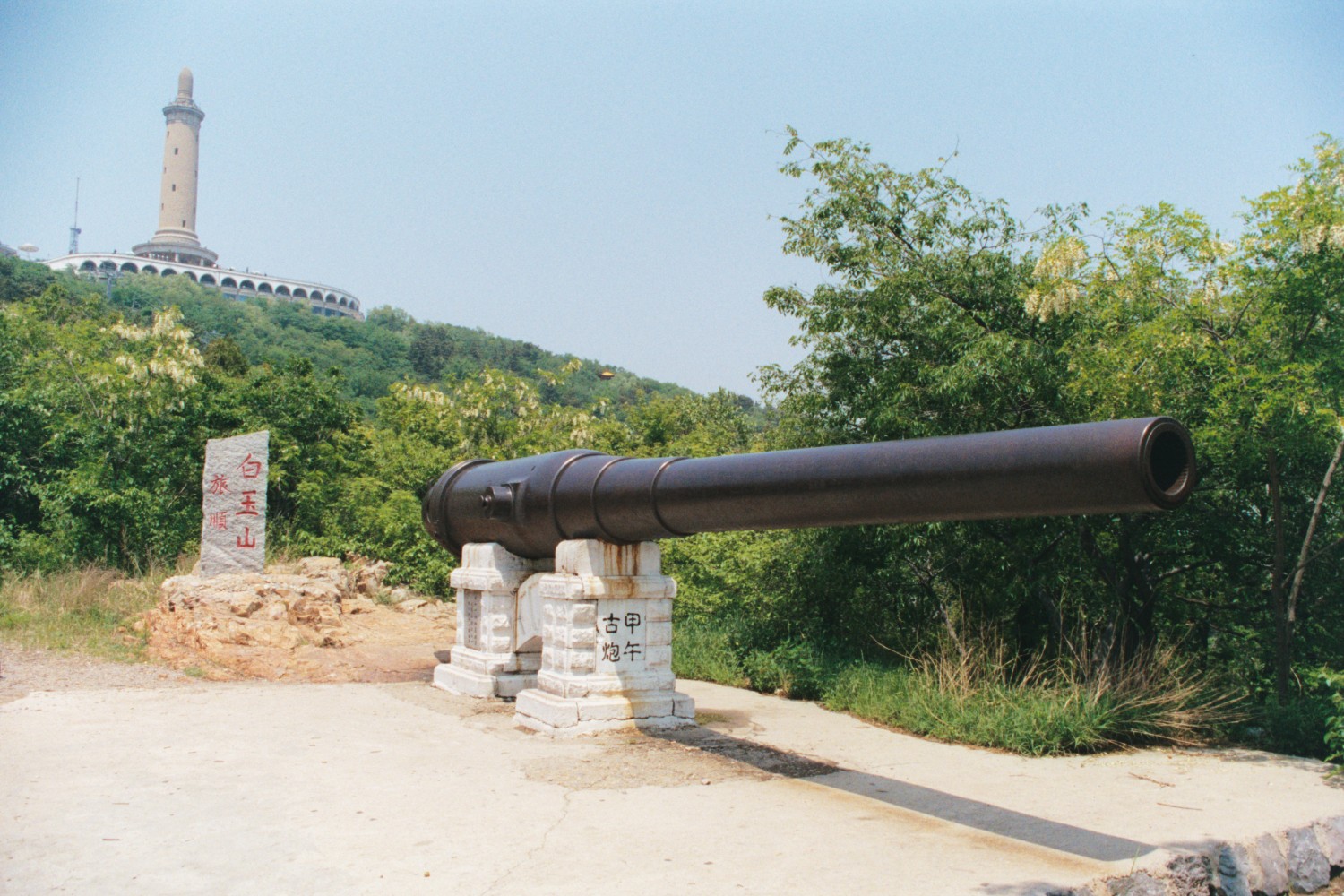
|
|
Lushan: the Baiyushan
memorial and Russian coast defence piece |
The
best place to view all of this is from the
Baiyushan
Tower
set on the hill which dominates the harbour.
This is one of the “off limits” sites but my Hong Kong Identity
Card got me in. The souvenir
vendors inside took my wife to be my tour guide, so they gave her a hard
time for bringing a foreigner into the place. This did not stop them
from trying to sell me model tanks, jets and destroyers made out of,
hopefully, spent 12.7 mm machine gun bullets and speaking to me in Russian.
However, the few words that I learned on a trip on the Trans-Siberian
Railway came in very handy and we were soon all bosom Tovarovichs!
The
tower was erected by the Japanese to commemorate their dead, and
re-dedicated by the Chinese to commemorate theirs.
From the terrace you can look down on the port built to accommodate
Admiral Ting’s fleet where the Russian First Pacific Squadron met its end;
see why the “Tiger’s Tail” is so aptly named; and ponder on the narrow
entrance to the harbour that the Japanese tried several times to block.
On a summer’s afternoon in 2005, or on a chart in the Mikasa
standing offshore in 1904, it looks a relatively easy task to obstruct this
entrance with blockships. But,
as the Americans discovered at
Santiago
and the British at Zeebrugge, at night, blinded by searchlights and shell
splashes and with the blockships sailing to seemingly certain destruction by
the enemy’s fire, such an easy task was practically impossible.
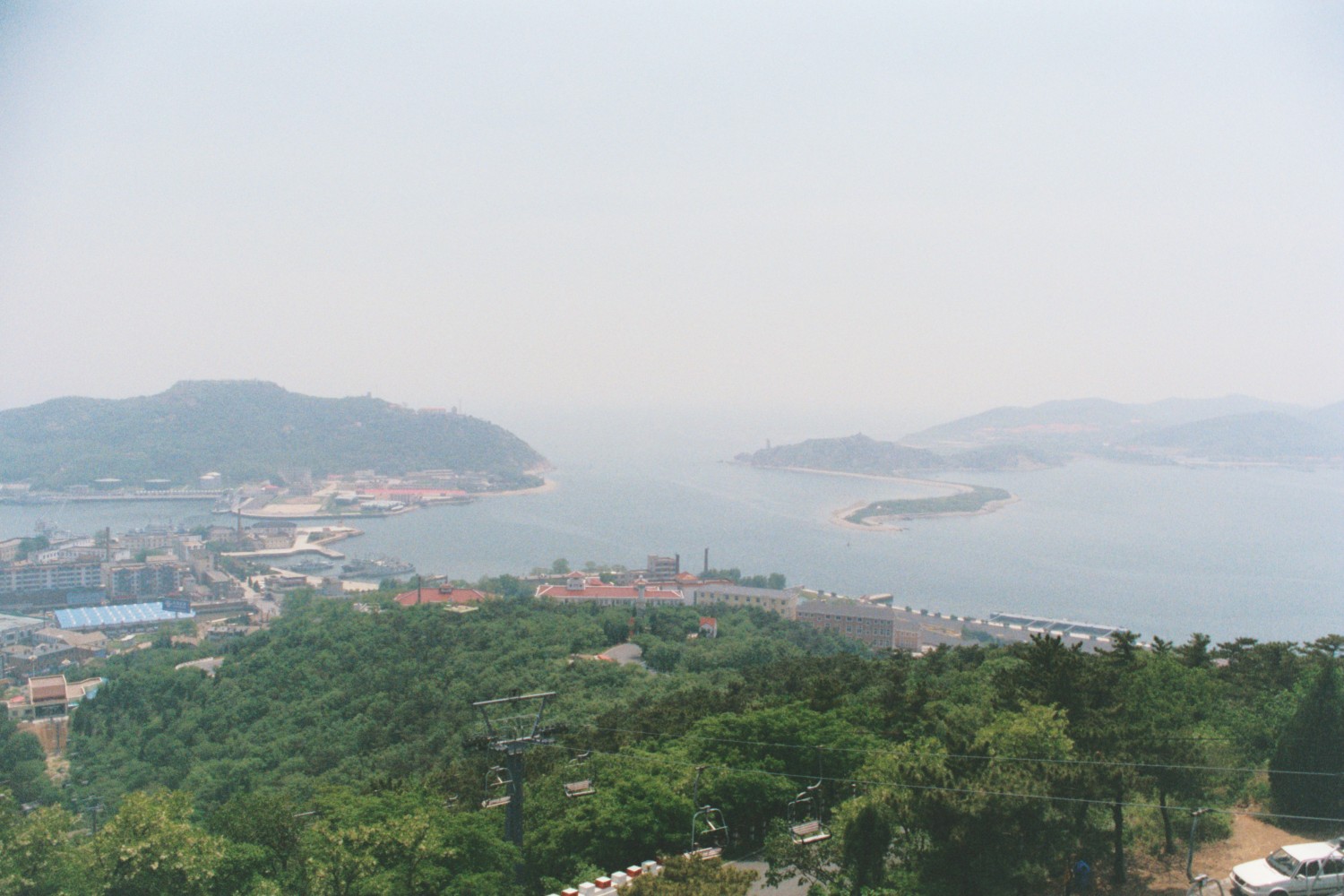 |
|
The
view from the memorial
The
dockyard on the left, the "tiger's tail" on the right and
between the narrow entrance that the Japanese couldn't block |
There
is a display of modern naval equipment at Baiyushan but I didn’t want to
push my luck with my Hong Kong ID too far so I didn’t go in.
On the road down from the hill you can take a photo opportunity with
an original Russian coast defence piece.
The
Memorial Hall of the Ten Thousand Martyrs Mausoleum commemorates the
Japanese massacre in 1894. It is
“on limits” and, in addition to its main purpose as a shrine, includes a
largely picture based commemoration of the Sino-Japanese War and the
Massacre. A 3 lber and the
5.9” stern chaser of the Tsi Yuen complete her raised firepower shared
with Liu Kung.
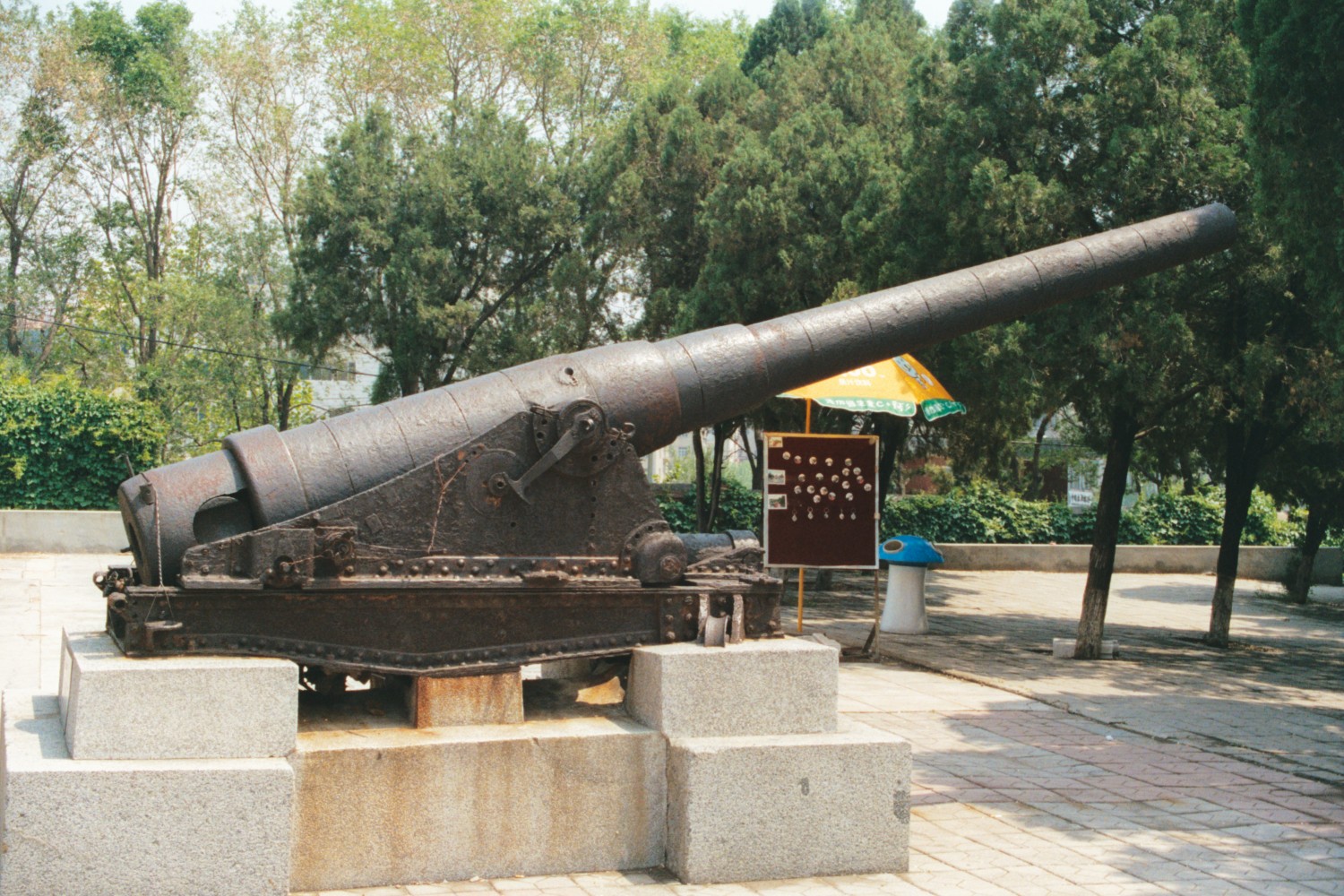 |
| Tsi Yuen's
15cm stern chaser |
The
hut where the Russians surrendered to the Japanese in 1905 is preserved, and
“on limits” but it is just, well… a hut.
The admission is about double that for most of the other historical
sites too ~ all-in-all it is not worth the price.
Hill
203 is “on limits”, and surprisingly far out from the centre of town.
It is well worth the admission though.
A steep but well paved road leads to the top.
If you want a real throwback to the bad old colonial days you can get
two coolies to carry you up in a sedan chair! Apparently
nobody but me thought that this was both anachronistic and unacceptable, as
I risked the heart attack and made the top under my own steam.
At the top is a small Japanese memorial in the shape of a rifle
cartridge. In 1894 General Nogi
took Hill 203 on the first day of assault and cracked the Chinese defences.
In 1904 it took him six months and thousands of casualties to do the
same. His son was killed just
below the summit. There is a
small monument to the younger Nogi where the trench lines have been
preserved.
Having
taken Hill 203 the Japanese could look down on
Port Arthur
. They brought in 11”
howitzers, which ironically, had originally been mounted as coast defence
weapons to protect the
Japanese
Home
Islands
from the Russian fleet, and used them as coast offence weapons to destroy
the same fleet. Crude, half
scale replicas of the Japanese and Russian artillery have been installed on
the hill but, having seen the real things at Liu Kung, these just look
tacky. Although the artillery
might have changed, the view is the same 100 years later, and that makes the
whole visit worthwhile. The day that I was there was quite hazy, and I could
barely make out the harbour… but in my mind’s eye it was easy to see the
shell splashes that marked the beginning of the end of the Russian First
Pacific Squadron.
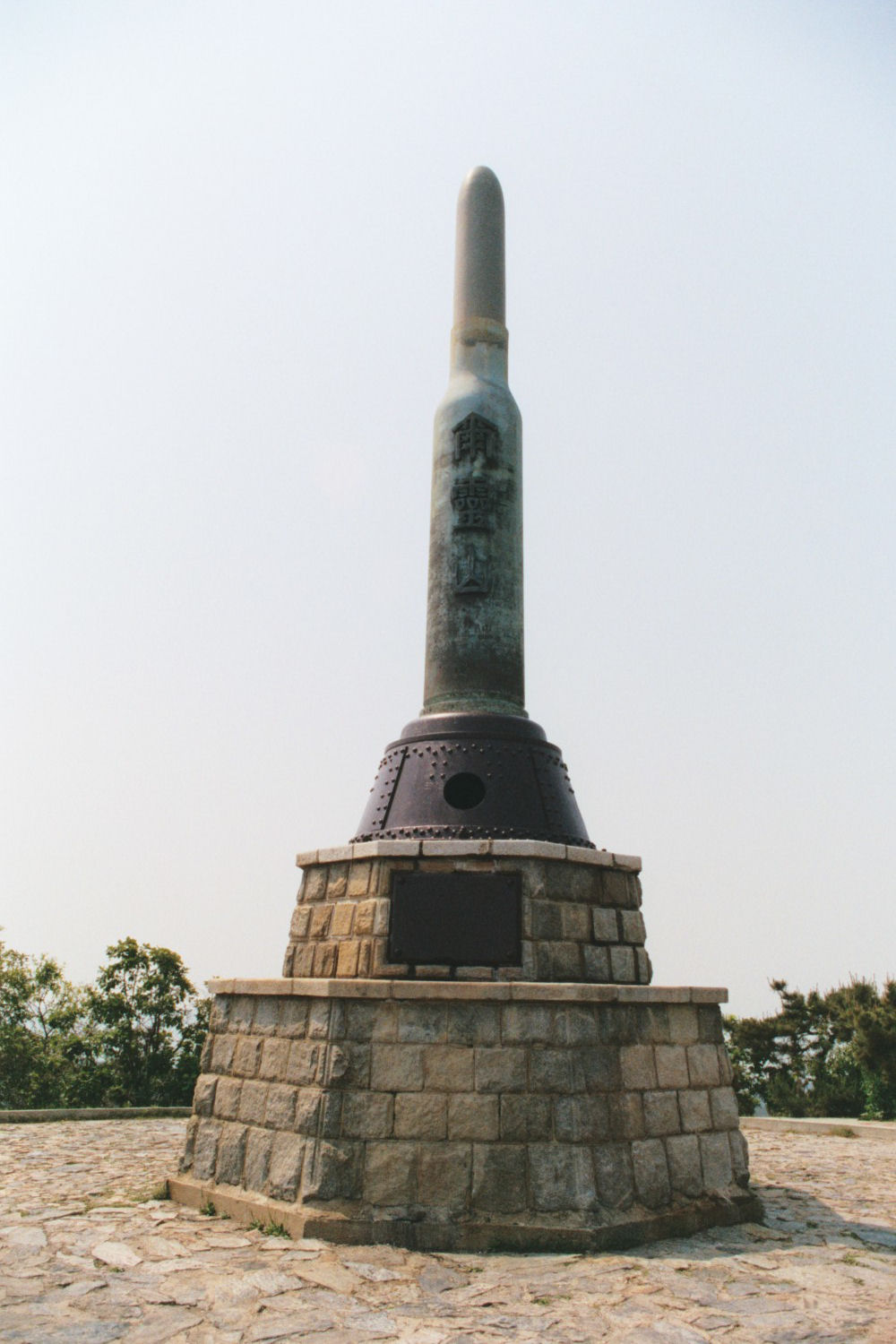 |
| The 'subtle'
Japanese monument on Hill 203 |
The
defences of Lushan are well covered in several photo based books which I had
bought and poured over. This
made the “off limits” business all the more frustrating as I knew what I
was missing. But, despite a
beguiling smile, Hong Kong ID and Pidgin Russian I was not able to effect
entry to any of the other sites. Anyway
the whole trip from Dalien had taken about four hours and I had seen much of
what I wanted so I left happy. But
I will still be happy to return… when they realise that the
Russia-Japanese War is over and that the defences of Lushan are just as
redundant as those of Liu Kung.
So
there you have it. If your thing
is pre-dreadnought era technology, or if your thing is Chinese, Japanese or
Russian Military history, then the shores of the
Yellow Sea
are the place to be. It is good
to see what is preserved, and, in the case of the Ting Yuen what has been
rebuilt. The world’s newest
pre-dreadnought battleship and the sites at Port Edward and
Port Arthur
exist today so that the lessons of the past can be learned, and Liu Kung and
Lushan will not relive their turbulent pasts or be re-named again.
back to
other
periods or back
to expeditions
|